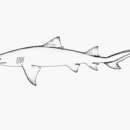Biology
provided by Arkive
The lemon shark has been the subject of one of the most long-term and intensive studies on a shark species. Much of what is known about this shark is due to the work of Dr Samuel Gruber and his colleagues. This predator is most active at dawn and dusk, and occurs singly or in loose aggregations of up to 20 individuals. It feeds primarily on fishes, including sea catfishes, mullet, stingrays and eagle rays, but also on crustaceans and molluscs. During the day they often lie quietly on the seabed, apparently resting, but in reality this behaviour uses up more energy than when swimming, due to the extra effort required to pump water over the gills (2). Therefore, they may be lying motionless waiting for wrasses or other small reef fishes to clean them of any parasites (3).
The lemon shark is viviparous; the embryos develop inside the mother and receive nutrients via a yolk sac placenta. After a gestation period of 10 to 12 months, pregnant females enter shallow nursery areas in spring and summer to give birth to litters of 4 to 17 pups. The pups have a very slow growth rate and remain within nursery grounds for a considerable length of time, where they are less vulnerable to predation by larger sharks (2). The mangroves that the young frequently inhabit are highly productive waters, creating a marvellous site for feeding, but also an area of very low oxygen content. Luckily, the lemon shark has numerous adaptations that enhance oxygen uptake, such as blood with an unusually high affinity for oxygen, and thus the pups can lie feeding in the rich waters, protected from any large potential predators by the mangrove's tangled roots (2) (6). As they grow, their range expands dramatically, from six to eight kilometres up to around 300 kilometres. Maturity is reached at about six and a half years of age, and it is believed that the lemon shark lives for up to 27 years (2).
Conservation
provided by Arkive
The lemon shark is not currently considered to be at risk from extinction, and there are no known specific conservation measures in place. However, it may gain some protection from the United Nations International Plan of Action for the Conservation and Management of Sharks. This requires that signatory states, such as Ecuador, Mexico and the United States, implement a national programme for the conservation and management of shark stocks, and carry out regular assessments of stocks (7).
Description
provided by Arkive
This stocky, powerful shark is named for its pale yellow-brown to grey skin, which lacks any distinctive markings. This provides perfect camouflage when swimming over the sandy seafloor in its coastal habitat (3). It has a flattened head with a short, broad snout, and the second dorsal fin is almost as large as the first (2). The lemon shark's retina has a specialized horizontal band across the middle, which is disproportionately rich in cones that discern fine detail and colour in well-illuminated conditions. This 'visual streak' is thought to provide the shark with a particularly clear view of its underwater world (4). This shark is potentially dangerous to humans due to its large size and powerful bite, and though there have been some unprovoked attacks, many were the result of provocation from divers and swimmers (2) (3).
Habitat
provided by Arkive
The lemon shark occurs over continental shelves, from the surface down to a depth of least 92 meters. It usually occurs around corals keys, at the fringes of mangroves, around docks, in saline creeks, in enclosed bays and at river mouths. It occasionally travels short distances upriver, entering freshwater, and also ventures into the open ocean when migrating (2) (5).
Range
provided by Arkive
Occurs in the tropical western Atlantic, from New Jersey to southern Brazil; and in the north eastern Atlantic, off west Africa. It is also occasionally found in the eastern Pacific, from southern Baja California and the Gulf of California to Ecuador (2) (5).
Status
provided by Arkive
Classified as Near Threatened (NT) on the IUCN Red List (1).
Threats
provided by Arkive
The lemon shark is caught in commercial and recreational fisheries; for their meat, skin, fins for soup, and liver for vitamin-rich oil (2). There is some evidence indicating that this exploitation is depleting populations in the eastern Pacific and western Atlantic (1) (5). The shallow, coastal nursery grounds are susceptible to human-induced habitat degradation (1) (5), particularly mangrove swamps which are being destroyed to make way for shore front hotels and shops throughout the Gulf of Mexico, Bahamas and Caribbean region (6).

